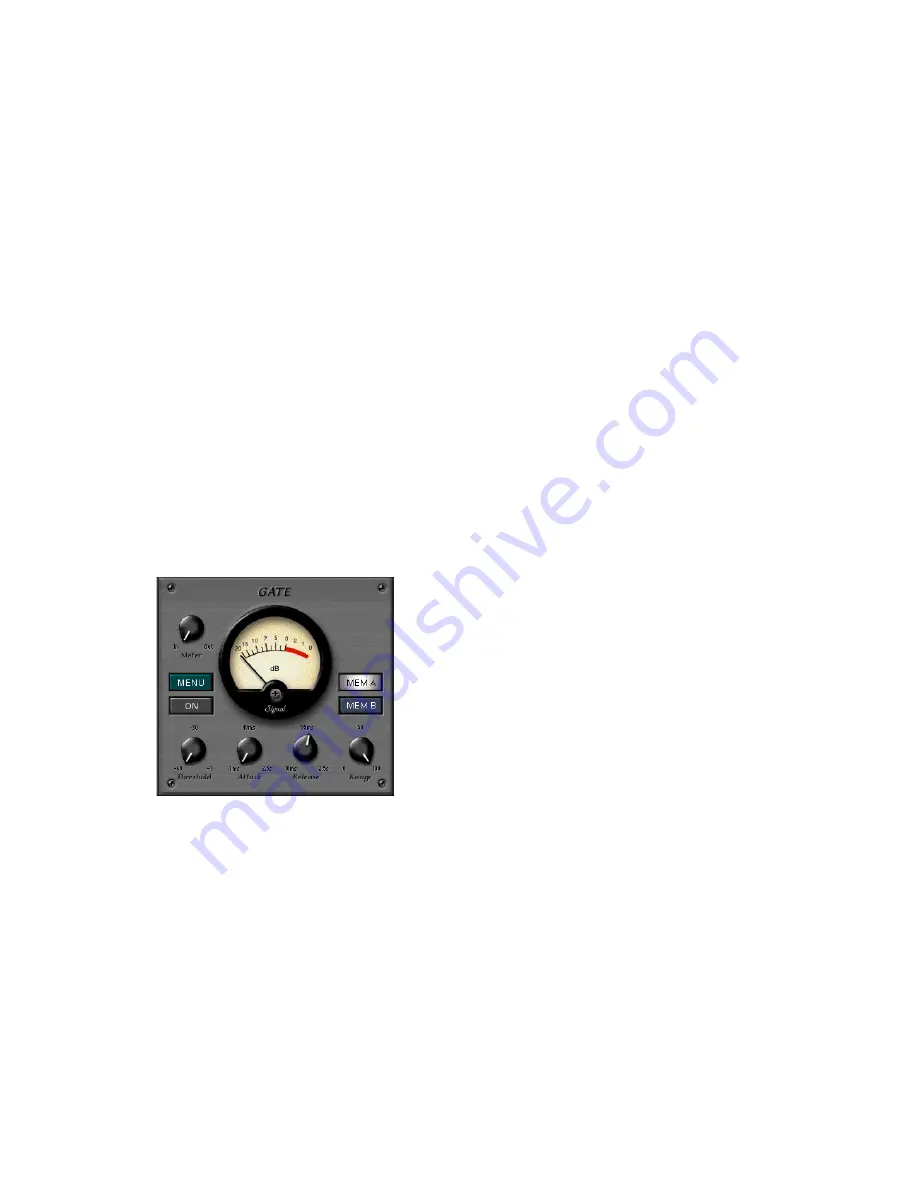
D8B Manual • Chapter 3 • page 80
SOFT
• This button turns on the soft-knee function, which
determines the severity of the compression action.
When highlighted, compression is smoother and
more gentle.
• When SOFT is not highlighted, the compression or
limiting action is more immediate and extreme.
ON
• Click the ON button to turn on the compressor for
the selected channel.
MENU
• Click the MENU button to Open, Save, Reset,
Undo, Cut, Copy, and Paste an Compressor patch.
MEM A/B
• Each MEMory stores the most recent MEM A or
MEM B EQ settings made for the selected channel.
• Click either of these memory positions to instantly
select the stored settings.
• Ideal for making quick A/B comparisons between
compressor settings.
Gate
The meter in the Gate section indicates either
the input signal level or the output signal level,
depending on the setting of the Meter switch next
to the meter. This setting is global and is not
recalled with any individual channel. The default
meter setting is “In” (Input level).
The I/O Signal meter displays the channel
input signal, as measured at the post-Digital Trim/
pre-Compressor point. The channel output is
measured at the post-Gate/pre-EQ point, with a
range of –20 dBFS to 0 dBFS (the best signal-to-
noise range). Even though this meter occupies a
chunk of screen real estate in the Gate region, the
needle movement is not directly displaying the Gate
operation, but instead reflects the total gain
contribution from the Digital Trim, Compressor,
and Gate functions (when “Out” is selected).
Additionally, on the I/O signal meter there is a
“signal present” indicator (the green LED), which
lights if the signal is above “minus infinity” dB
(the same minimum range as the channel meter
bars). At –20 dBFS, the needle movement kicks in.
The red LED, on the bottom right of the meter,
is a “gate threshold” indicator and lights up to
indicate when the Gate is on.
Remember that additional channel metering is
found on the console’s channel strips (post-EQ,
pre-Fader) and also at the dual-solo meters
(sharing duties with the L/R meters), indicating
either PFL (post-EQ) or AFL levels, as determined
by the solo section assignment.
Threshold
• Determines the level at which the gate acts on the
incoming signal. It is calibrated in decibels,
ranging from –60.00 dB to –1.00 dB.
Attack
• Determines how fast the gate opens once the
threshold has been exceeded. It is calibrated in
milliseconds, ranging from 0.10 ms to 599.99 ms.
Release
• Determines how fast the gate closes once the
signal falls below the threshold. It is calibrated in
milliseconds, ranging from10.00 ms to 2500 ms
(2.5 seconds).
Range
• Determines the change in output level as a
function of the change in input level, once the
signal level drops below the threshold. This is
sometimes called downward expansion. It is
calibrated in decibels, ranging from 0.00 dB to
100.00 dB.
ON
• Click the ON button to turn on the gate for the
selected channel.
MENU
• Click the MENU button to Open, Save, Reset,
Undo, Cut, Copy, and Paste an Gate patch.
MEM A/B
• Each MEMory stores the most recent MEM A or
MEM B EQ settings made for the selected channel.
• Click either of these memory positions to instantly
select the stored settings.
• Ideal for making quick A/B comparisons between
gate settings.
Summary of Contents for D8B 3.0
Page 8: ...D8B Manual Preface page 2 ...
Page 9: ...D8B Manual Chapter 1 page 3 Chapter 1 Getting Ready ...
Page 27: ...D8B Manual Chapter 2 page 21 Chapter 2 Where Is It ...
Page 47: ...D8B Manual Chapter 3 page 41 Chapter 3 What s On TV ...
Page 93: ...D8B Manual Chapter 4 page 87 Chapter 4 Applications ...






























